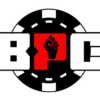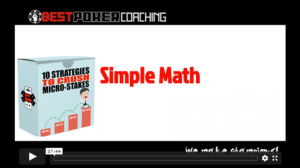[av_textblock size=” font_color=” color=” admin_preview_bg=” av_uid=’av-4r9t3fr’]
Are you overestimating your hand strength?
[/av_textblock]
[av_codeblock wrapper_element=” wrapper_element_attributes=” av_uid=’av-17p5w38n’]
[/av_codeblock]
[av_textblock size=” font_color=” color=” admin_preview_bg=” av_uid=’av-12347dpj’]
The video above is taken from our 6-max coaching sessions.
It’s a specific type of coaching session, where the coach – in this case BPC Head Coach Gordon – comments on the video submitted by a student.
The student is required to analyse hands systematically, and the coach corrects his thinking process.
A common mistake many players make, is overestimate their hand value.
Whereas a computer would think in terms of 1st best hand, 2nd best hand, 3rd best hand, and so on…
Humans tend to think in terms of “two pair”, “top pair”, etc.
This can lead to significant mistakes at the table, as is evident in the video above, where the student is deciding between slowplaying or fastplaying his hand – when in reality, he often only has a bluff-catcher!
For example…
In the very first hand, the student had QJs.
The UTG player raises preflop, and hero calls from the CO.
Calling on the CO vs the UTG range is completely fine, and it is in the calling range from the preflop chart given to the student.
You can also see a reasonable opening range for a tight opponent: on the screenshot chart below:
[/av_textblock]
[av_image src=’https://devel.bestpokercoaching.com/wp-content/uploads/2017/08/villain-vs-hero-range.png’ attachment=’335640′ attachment_size=’full’ align=’left’ styling=” hover=” link=” target=” caption=’yes’ font_size=” appearance=’on-hover’ overlay_opacity=’0.4′ overlay_color=’#000000′ overlay_text_color=’#ffffff’ animation=’no-animation’ admin_preview_bg=” av_uid=’av-zl8cgvb’]
Villain opening range on the left, hero calling range on the right.
[/av_image]
[av_hr class=’invisible’ height=’30’ shadow=’no-shadow’ position=’center’ custom_border=’av-border-thin’ custom_width=’50px’ custom_border_color=” custom_margin_top=’30px’ custom_margin_bottom=’30px’ icon_select=’yes’ custom_icon_color=” icon=’ue808′ font=’entypo-fontello’ admin_preview_bg=” av_uid=’av-vfhttrb’]
[av_textblock size=” font_color=” color=” admin_preview_bg=” av_uid=’av-2g7u7fr’]
The flop comes KsQcJc and the opponent makes a continuation bet.
The student makes a raise.
At this point, let’s think about which hands our opponent will call our raise with.
We have two options – we can give him an “optimistic range”, and a “pessimistic range”.
In the optimistic variant, we give him the range with the best scenario for us; and in the pessimistic, the worst for us.
Why do we do that?
To get a better idea of his range, and to better understand the factors involved, when making our decision.
For example, let’s say we assign villain a pessimistic range and see that we can profitably raise even against that range.
Now we know we can safely raise, since we have a value hand even if we assume the worst case scenario.
That also holds true the other way around.
In this hand, we need at least 50% equity against his continuing range, to make a raise profitable.
That means, when we raise, and he calls – we should on average beat his calling range.
Let’s have a look at the image below.
On the left, we can see a very optimistic range for villain. In this scenario we assume he will call our raise even with hands as weak as 2nd pair, for example.
On the right, we gave him a more realistic, or “pessimistic” range, in which case he will call us only with strong hands.
As you can see, our equity with QJs is below 50% against both ranges:
[/av_textblock]
[av_image src=’https://devel.bestpokercoaching.com/wp-content/uploads/2017/08/optimist-vs-pessimist.png’ attachment=’335636′ attachment_size=’full’ align=’left’ styling=” hover=” link=” target=” caption=’yes’ font_size=” appearance=’on-hover’ overlay_opacity=’0.4′ overlay_color=’#000000′ overlay_text_color=’#ffffff’ animation=’no-animation’ admin_preview_bg=” av_uid=’av-k1smgmf’]
Optimistic range on the left, pessimist on the right.
[/av_image]
[av_hr class=’invisible’ height=’30’ shadow=’no-shadow’ position=’center’ custom_border=’av-border-thin’ custom_width=’50px’ custom_border_color=” custom_margin_top=’30px’ custom_margin_bottom=’30px’ icon_select=’yes’ custom_icon_color=” icon=’ue808′ font=’entypo-fontello’ admin_preview_bg=” av_uid=’av-em5xxt3′]
[av_textblock size=” font_color=” color=” av-medium-font-size=” av-small-font-size=” av-mini-font-size=” av_uid=’av-bah7wvb’ admin_preview_bg=”]
Since we are behind his calling range even assuming an optimistic scenario where villain continues with some very weak hands – we should never raise here.
We have a bluff-catcher, not a value hand.
Even assuming villain is very bad, and will call a raise with second and third pairs – hero is still behind his range (as you can see in the optimistic range)
The student in the video misplays his hand, and keeps making similar mistakes.
This is something you’ll see often in the video. The student didn’t know anything about relative hand strength, but now he knows. Gordon taught him a really important lesson in this video.
After this coaching session, he will not repeat them again.
Watch the full video above, and save yourself lots of buyins by not stacking off with what looks like a good hand, but in reality – it simply isn’t.
[/av_textblock]



